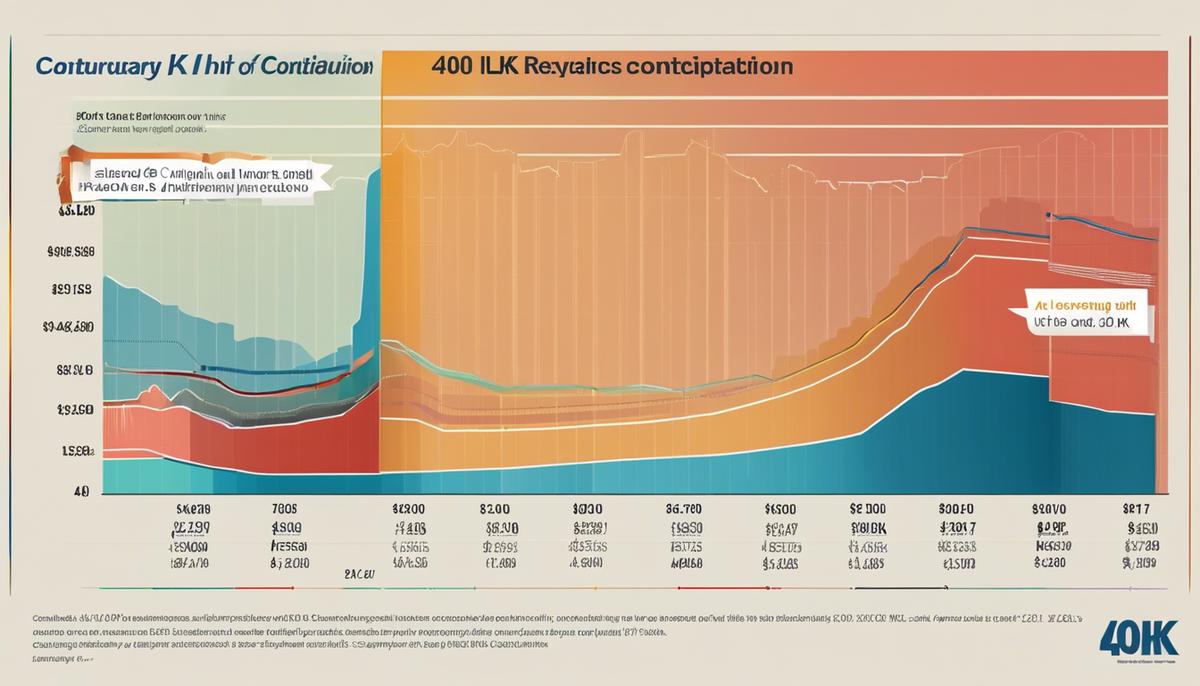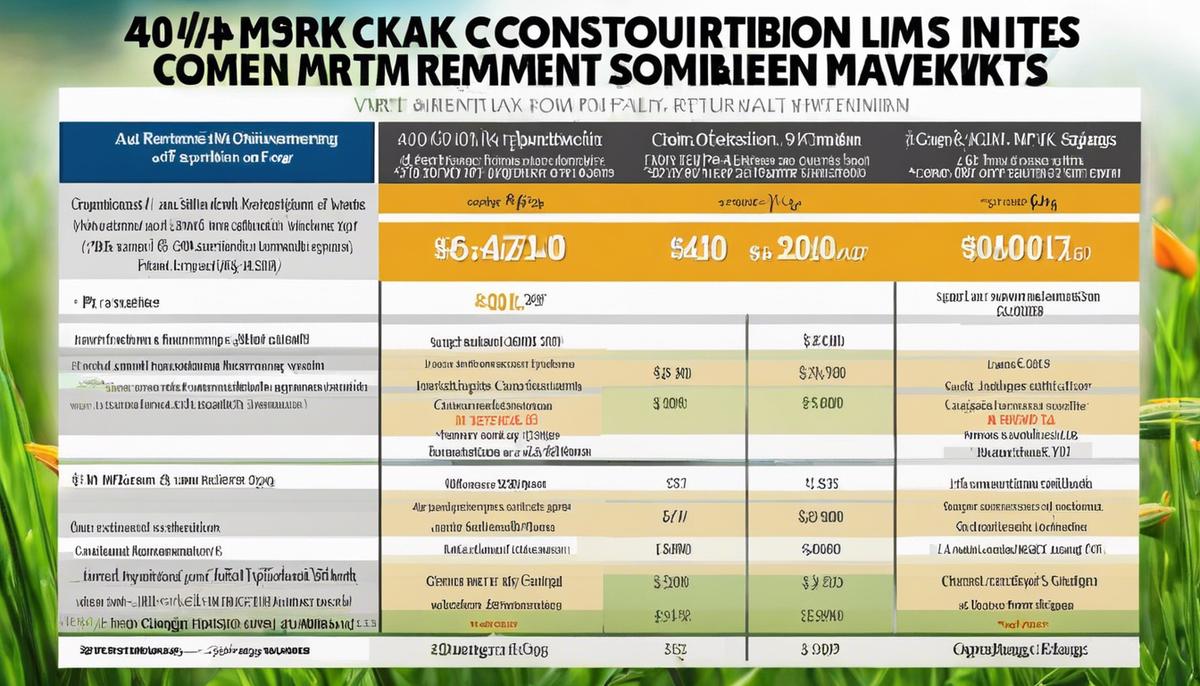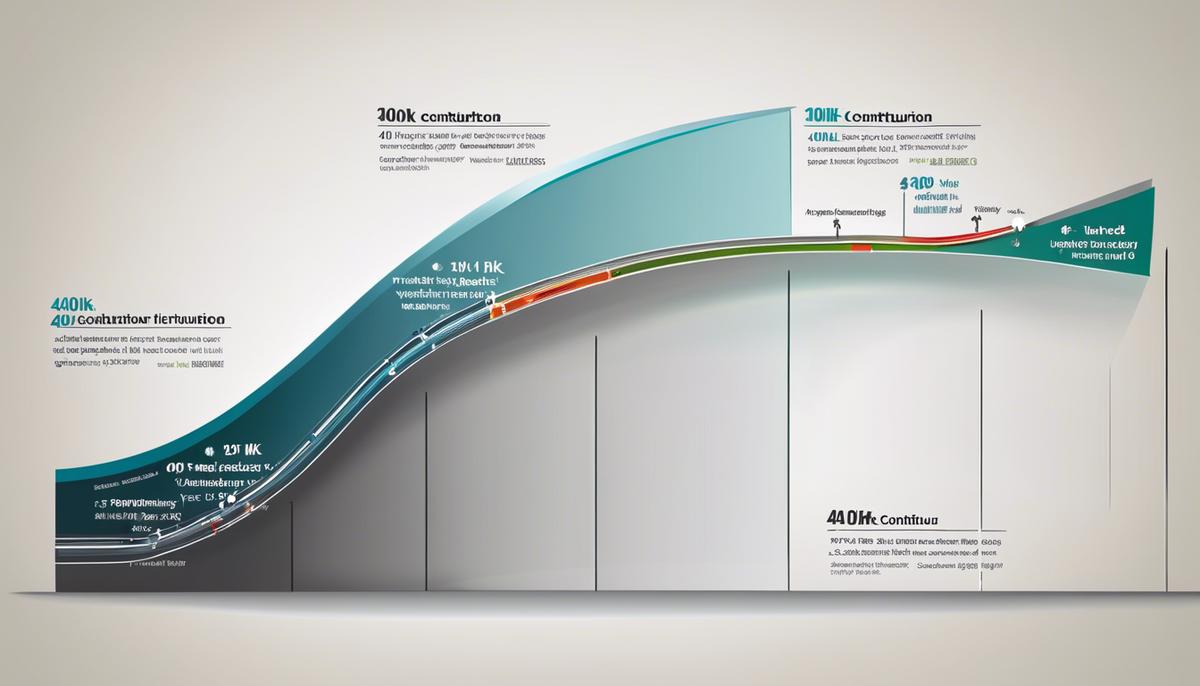401(k) Contribution Limits Guide 2024
The landscape of retirement savings in the United States has experienced a considerable evolution over the years, reflecting an ongoing balancing act between fostering individual financial autonomy and providing regulatory guidance. As we cast our gaze onto the kaleidoscope of historical trends, legislative foundations, and their subsequent impacts on retirement security, it becomes evident that the trajectory of 401(k) contribution limits is not merely a financial measure but a mirror reflecting the changing tides of economic policy and societal values. Through a dissection of these multifarious facets, we embark on a journey to comprehend the underpinnings and future course of one of the most significant instruments in building financial security for the American workforce.
Historical Trends in 401(k) Contribution Limits
The Trajectory of 401(k) Contribution Limits: An Insight into the Evolutionary Financial Landscape
Since its inception in 1978, the 401(k) plan has stood as a cornerstone in the edifice of American retirement planning. Initially regarded as a supplementary avenue to traditional pension frameworks, the 401(k) plan has since burgeoned in prominence as a primary vehicle for retirement savings. As such, it is imperative to chronicle the evolution of its contribution limits, which are pivotal influencers on the capacity for individuals to accumulate retirement wealth.
Let us delve into the analytical reconnaissance of how these contribution limits have been shaped by legislative and economic forces through the annals of time.
The inception point for the 401(k) saw a modest annual contribution limit of $45,000, a ceiling set to encompass both employee and employer contributions. It is essential to recognize that, within this embryotic period, individual employees were confined to contribute a maximum of 15% of their earnings.
Escalating to the 1980s, a decade that witnessed considerable economic oscillations, the Internal Revenue Service (IRS) discerningly modified the contribution proposition. In 1982, the individual limitation was firmly ensconced at $30,000, thereby inaugurating the practice of periodically adjusting this threshold to reflect shifts in the economic climate and cost of living.
The following decades marked a steady increment in contribution limits, a trajectory both grounded in inflationary accommodations and spurred by legislative initiatives. Notably, the introduction of the ‘catch-up’ contribution concept in 2001 under the Economic Growth and Tax Relief Reconciliation Act (EGTRRA) emerged as a pivotal juncture in 401(k) history. This provision granted individuals aged 50 or older the prerogative to contribute additional funds beyond the standard limit, a stratagem designed to bolster the retirement readiness for the maturing workforce demographic.
Advancing to the contemporary era, the Protecting Americans from Tax Hikes (PATH) Act of 2015 stands as the most recent legislative artifact to influence 401(k) contribution boundaries. This act cemented the conventions of indexed increments, perpetuating the dynamic adaptation of contribution limits in alignment with inflationary patterns.
To precis the historical journey and envisage the 2022 fiscal landscape, individuals are allowed to allocate up to $19,500 with an additional ‘catch-up’ summit of $6,500 for those aged 50 and beyond. This indicates a marked progression from the program’s genesis, reflecting both a responsive legal framework and a deep-seated recognition of the necessity for robust retirement reserves.
This synoptic overview of the 401(k) contribution limit evolution embodies a testament to the maturing intricacies of personal finance within the United States. It underscores a legislative commitment to facilitating adequate retirement provisions and encapsulates a facet of the ever-adjusting financial paradigm in which the modern American employee must navigate.
Thus, as one contemplates the 401(k) mechanism within the grander tableau of retirement planning, it is crucial to perceive these temporal modifications not as mere statistical fluctuations, but as indispensable reflections of socioeconomic ingenuity and foresight.

Legislative Foundations of 401(k) Contribution Limits
United States federal law establishes an intricate framework for the regulation of 401(k) plans, an integral aspect of retirement savings for many American workers. These financial constructs exist under the auspices of the Internal Revenue Code (IRC), which specifies the operational tenets, including the annual contribution limits and prerequisites for both employees and employers utilizing these tax-advantaged savings accounts.
The Employee Retirement Income Security Act of 1974 (ERISA) plays a significant role in the guidance of 401(k) plans, while the Revenue Act of 1978 — particularly Section 401(k) — allowed for the creation of these tax-deferred, defined-contribution plans. It is paramount to note that the IRC and ERISA are augmented by periodic legislation aimed at adjusting retirement planning policies to reflect current economic conditions and fiscal goals.
One core aspect of these legislative provisions is to ensure that 401(k) plans serve their purpose without becoming a tax evasion tool, thereby establishing the upper limits of contributions. Consequently, each year, the Internal Revenue Service (IRS), in alignment with cost-of-living adjustments and legislative mandates, may revise these limits. This dynamism underscores the commitment of lawmakers and regulators to adapt to inflation and the evolving financial needs of retirees.
Additionally, the allocation of catch-up contributions serves as a strategic tool to incentivize and enable individuals nearing retirement age to accelerate their savings, acknowledging the time-sensitive nature of retirement planning. This legislative component exemplifies the targeted efforts to ensure that the 401(k) system addresses the diverse economic circumstances of participants.
With the objective of bolstering retirement savings, legislation such as the Pension Protection Act of 2006 brought forward advanced fiduciary guidelines, which also tangentially impacted 401(k) savings behavior. The Act’s provisions encouraged plan automatization, which, albeit indirectly, could influence personal contributions by increasing plan participation rates and, subsequently, aggregate savings.
In synthesizing the legislative frameworks, it is evident that the intricate milieu of regulations and periodic legislative updates coalesce to construct a robust yet flexible system designed to navigate the complex financial landscape of retirement savings. While the majority of individuals may perceive these regulations as static annual figures, the backdrop is an adaptable and responsive legislative schema purposed to cater to both individual needs and socioeconomic stability. Such legislative diligence ensures the 401(k) remains a vital and effective component within the broader tapestry of retirement planning for numerous Americans.

Impact of 401(k) Contribution Limits on Retirement Security
The magnitude of influence that the 401(k) contribution limits have on individual retirement security is substantial.
It is through these regulations that a balance is sought between the needs of the present and the demands of the future. The savings accumulated within these tax-advantaged retirement accounts stand as one of the primary fortresses against financial uncertainty in post-employment years.
Diligent contributions to a 401(k) plan throughout an individual’s career can create a critical bulwark for retirement.
However, the imposed limits guide the maximum amount that may be allocated within a given tax year. A cap, on one hand, serves as a form of fiscal policy intended to temper the immediate tax revenue losses to the federal government. On the other, it can act as a ceiling which curtails the potential growth of an individual’s retirement nest egg.
The relationship between 401(k) contribution limits and retirement security is complex.
When individuals can save only up to a certain point, those with higher incomes may find the ceiling less of a constraint than those with modest earnings. Consequently, this can exacerbate income inequality into retirement. A consistent finding that surfaces in research is the disproportionate advantage in favor of high earners, who can more readily approach the annual limit, hence maximizing the benefit from the deferred tax arrangement.
Moreover, the interplay between the cost-of-living adjustments and the contribution limits necessitates vigilant attention.
While these incremental elevations in ceiling thresholds aim to preserve the purchasing power of retirement savings, inflationary periods can dilute the real-term improvements that such adjustments propose to deliver.
The efficacy of existing contribution limits in promoting a secure retirement may also be scrutinized through the demographic lens.
For younger workers, the current caps may appear distant and inconsequential.
Nonetheless, the power of compounded growth over time underscores the utility of maximizing contributions early and consistently. In contrast, older individuals, particularly those who commenced their savings journey later in life or experienced financial disruptions, perceive the limit as an ever-looming barrier to sufficient retirement preparedness.
In addressing retirement security within the structure of 401(k) plans, adjustments in contribution limits must be reconceived as not merely a numeric threshold but a lever that can significantly alter the long-term financial stability of an individual.
Policymakers and financial experts continue to explore modifications that could optimize these limits, ensuring they remain relevant to the evolving economic conditions and the shifting demographics of the American workforce.
The impact of 401(k) contribution limits on individual retirement security is therefore not to be underestimated.
It demands ongoing evaluation and, where necessary, policy innovation to ensure that the spirit of these savings vehicles remains intact: to facilitate a comprehensive and adequate foundation upon which retirement can rest with assurance and dignity.

Comparison with Other Retirement Savings Vehicles
Comparison of 401(k) Contribution Limits with Other Retirement Savings Vehicles
When scrutinizing retirement savings vehicles, it is imperative to compare the 401(k) contribution limits with those of other plans, such as Individual Retirement Accounts (IRAs), SIMPLE IRAs, and SEP-IRAs. This comparative analysis allows individuals to make informed decisions regarding their retirement planning strategies.
For the 2023 tax year, traditional and Roth IRAs present an annual contribution limit of $6,500 for individuals under the age of 50. This is significantly lower than the standard limit for 401(k) plans, which is $22,500. This gap in allowable contributions underscores the utility of the 401(k) as a robust vehicle for accumulating retirement savings. Moreover, those aged 50 and over can make an additional catch-up contribution of $1,000 to an IRA, compared to the $7,500 permitted in a 401(k).
Participants in a SIMPLE IRA, a retirement vehicle tailor-made for small businesses and self-employed individuals, are subject to different contribution limits as well. The cap for these plans is set at $15,500 for 2023, with a catch-up limit of $3,500 for those aged 50 and above. While higher than the IRA limits, these figures still fall short of the 401(k) thresholds, reflecting the distinct emphasis placed on 401(k) plans as a primordial tool for retirement savings.
SEP-IRAs, predominantly utilized by self-employed individuals and small business owners, offer a different structure altogether. Contributions to a SEP-IRA cannot exceed the lesser of 25% of the individual’s compensation or $66,000 for the 2023 tax year. This elevated ceiling can potentially surpass the contributions allowed in a 401(k), albeit contingent on the individual’s earnings. Consequently, for high-income earners, SEP-IRAs offer a dynamic avenue for retirement savings that can rival or exceed 401(k) plan contributions.
An integrated understanding of these retirement savings vehicles necessitates recognition of the varying advantages they proffer. While contribution limits serve as a metric for comparison, one must also consider factors such as investment options, tax treatment, and eligibility requirements, which are integral components of retirement planning.
The dichotomy between these contribution limits is not just a numerical disparity but a reflection of the targeted demographics and policy incentives embedded within each plan. As the nature of employment and retirement evolves, the architecture of these vehicles may be subject to modification, reflecting the dynamic interplay between economic conditions and legislative policy. Prioritizing knowledge dissemination regarding these vehicles remains at the heart of retirement security, ultimately ensuring well-informed decisions that uphold the financial wellbeing of current and future retirees.

Predictions for Future 401(k) Contribution Limits
Understanding the Possible Trajectory of 401(k) Contribution Limits
The historical progression of 401(k) plans serves as an insightful guide to the trajectory of contribution limits, which can be influenced by a confluence of factors. Closely following trends in legislation, economic indicators, and social dynamics allows for a prediction of future 401(k) contribution limits that deserve careful assessment.
As projected by a nuanced analysis of historical patterns and the regulatory framework of retirement plans, a key predictor of future 401(k) contribution limits is the rate of inflation. The Internal Revenue Service adjusts these limits based on the cost-of-living index, with the intent to preserve the purchasing power of retirement savings. If inflation experiences a significant rise, it is plausible to expect corresponding increases in contribution limits to facilitate effective retirement planning.
Additionally, demographic shifts, such as the aging population in the United States, may necessitate higher contribution ceilings. An older workforce may demand enhanced capacity to save in the later stages of their careers, potentially leading to further legislative adjustments.
The burgeoning national conversation around wealth inequality and the plight of underfunded retirements could spur policymakers to revisit existing frameworks. Modifications aimed at ameliorating disparities might include revising contribution limits to better serve lower-income individuals who are currently less able to contribute the maximum amounts.
Notably, federal deficit concerns and tax policy debates may also shape the future of 401(k) limits. Contributions to these plans offer immediate tax deferral which impacts government revenue. Policy shifts toward reducing the deficit could theoretically lead to a cap on deferrals, thereby impacting future contribution limits.
In the sphere of retirement savings, the trend has been towards offering greater flexibility and opportunity for accumulation of retirement funds. It is reasonable to predict that future limits on 401(k) contributions will potentially reflect this trend, accommodating growing life expectancies and altering retirement landscapes.
While detailed predictions remain the domain of careful actuarial and economic analysis, these factors foreground the possibility of upward adjusted contribution limits, contingent upon legislative responses to economic conditions. It is paramount that the retirement planning community and individual savers monitor these developments attentively, in order to optimize the efficacy of 401(k) retirement vehicles.

As we have traversed the intricate web of factors influencing 401(k) contribution limits, from historical evolution to comparative analysis with other retirement savings vehicles, we stand at the doorstep of the future, gazing into the realm of possibilities. The dynamic nature of economic shifts and legislative reforms suggests that navigating the retirement savings landscape will continue to be a complex yet vital endeavor. Empowered with knowledge and predictive insights, individuals and policymakers alike are better equipped to adapt to and shape the retirement planning ecosystem, fostering a society that values and secures the financial well-being of its members across the continuum of their working lives into retirement.



Leave a Reply